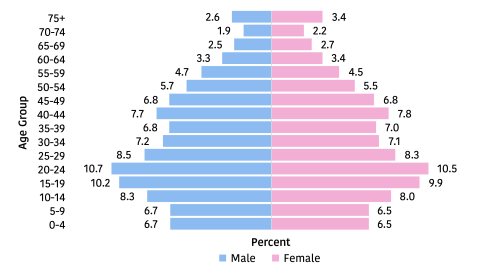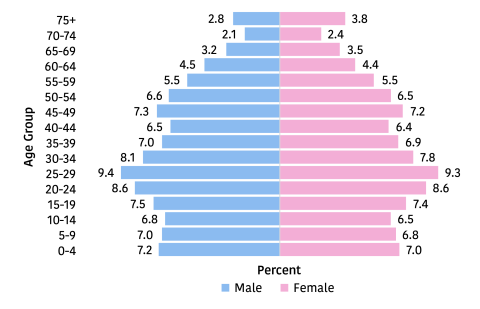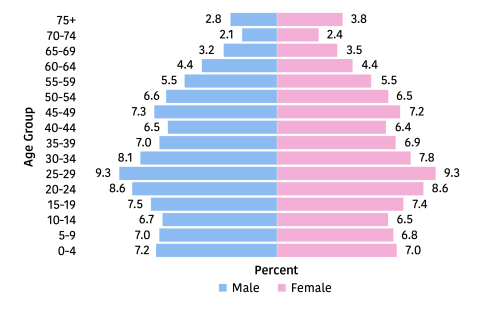Demographics of Trinidad and Tobago
GEOGRAPHICAL LOCATION
The Republic of Trinidad and Tobago is situated northwest of Venezuela, approximately 10-11 degrees north of the equator and 60-61 degrees west longitude. The country lies between the Caribbean Sea and the Atlantic Ocean. It consists of two islands separated by a channel approximately 31 kilometres wide. Trinidad covers an area of 4,828 square kilometres, while Tobago spans 300 square kilometres. The terrain is mostly flat, but Trinidad has three mountain ranges: the Northern, Central, and Southern ranges. The highest point in Trinidad is Mount El Tucuche, which rises to 940 meters. Tobago has a central mountain range.
TRINIDAD & TOBAGO POPULATION
This report covers new cancers diagnosed in residents of Trinidad and Tobago between 1st January 2003 and 31st December 2020 as of 1st March 2024. The report is divided into three 6-year categories: 2003–2008,2009–2014, and 2015–2020. Cancers diagnosed after this date will be included in subsequent reports. Calculations requiring Trinidad and Tobago population data used the estimated mid-year population data for 2005 and 2017 for the periods 2003–2008 and 2015–2020, respectively, whereas the 2011 population census was used for the period 2009–2014. All data was obtained from the Central Statistical Office (CSO) of Trinidad and Tobago.
Population Estimate 2005
Population estimates from June 2005 indicated a total population of 1,294,494, with 50.2% male and 49.8% female. Of the total population, 57.4% were under 35 years old. The dependent population comprised 28.9% of the total population estimate, including 21.3% under 15 years and 7.6% over 65 years of age.

Population Estimate 2011
The 2011 census indicated that the population was 1,328,019, with 50.1% male and 49.9% female. Of the total population, 54% were under 35 years old. The dependent population comprised 30% of the total population, including 21% under 15 years and 9% over 65 years of age.

Population Estimate 2017
Population estimates from June 2017 indicated a total population of 1,356,633, with 50.2% male and 49.8% female. Of the total population, 53.8% were under 35 years old. The dependent population comprised 29.6% of the total population, including 20.6% under 15 years of age and 9% over 65 years of age.

CULTURAL DIVERSITY IN TRINIDAD AND TOBAGO
The official language of Trinidad and Tobago is English. The population is ethnically diverse. The 2011 population census indicated the following ethnic composition:
CANCER DIAGNOSIS REPORTED BY LOCATION
Cancer cases were diagnosed by both public and private institutions. The cancer cases in the Registry were recorded from the following sources: CSO (36.1%), NWRHA (23.8%), NCRHA (12.2%), SWRHA (11.5%), Private Institutions (11.2%), ERHA (2.9%), TRHA (2.3%), and unspecified locations (0.1%).
Dr. Elizabeth Quamina Cancer Registry
HISTORY OF THE CANCER REGISTRY
The Dr. Elizabeth Quamina Cancer Registry, the National Cancer Registry of Trinidad and Tobago, was named after its pioneer and founder. Dr. Elizabeth Quamina, the nation’s first female Chief Medical Officer. She was an active member of the National Cancer Society and played a pivotal role in establishing cancer screening clinics. A cancer patient herself, Dr. Quamina continued her impactful work until her passing in 1997. This population-based registry was established in September 1994 as a project of the Trinidad and Tobago Cancer Society. Cancer registry procedures were established according to internationally accepted guidelines set by the International Agency for Research on Cancer (IARC). Initially, Advisory and Management Committees were formed to advise and guide the Director and Registrar, formulate policies and procedures, and assist in mobilising resources. In November 1998, recognising the need for cancer incidence data, the Registry became institutionalised within the Ministry of Health and has since been provided with office accommodation and regular funding. The Registry is now managed and administered through a tri-partite agreement among the Ministry of Health, the North Central Regional Health Authority (NCRHA), and the Trinidad and Tobago Cancer Society. IARC has a regional Cancer Registry Hub at the Caribbean Public Health Agency (CARPHA), which is a part of the Global Initiative for Cancer Registry Development (GICR). The IARC has played a substantial role in supporting international, regional, and local training.
TRINIDAD AND TOBAGO CANCER REGISTRY STAFF
The Dr. Elizabeth Quamina Cancer Registry, the National Cancer Registry, is operated by a dedicated team and managed in accordance with the National Health Service Plan and Policy established by the Ministry of Health and international standards. Details regarding the staff are provided in the Acknowledgements section of the report. All staff members of the Dr. Elizabeth Quamina Cancer Registry sign an oath of confidentiality, which is upheld even after their employment at the Registry.-